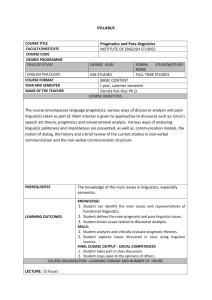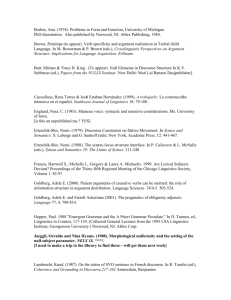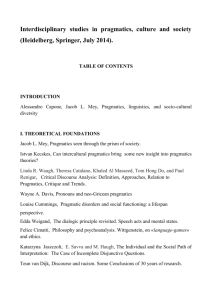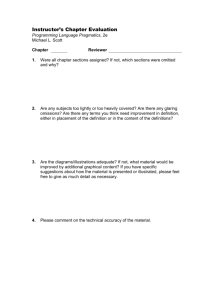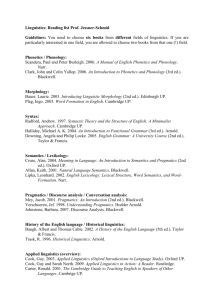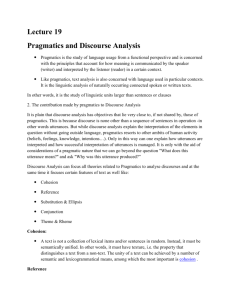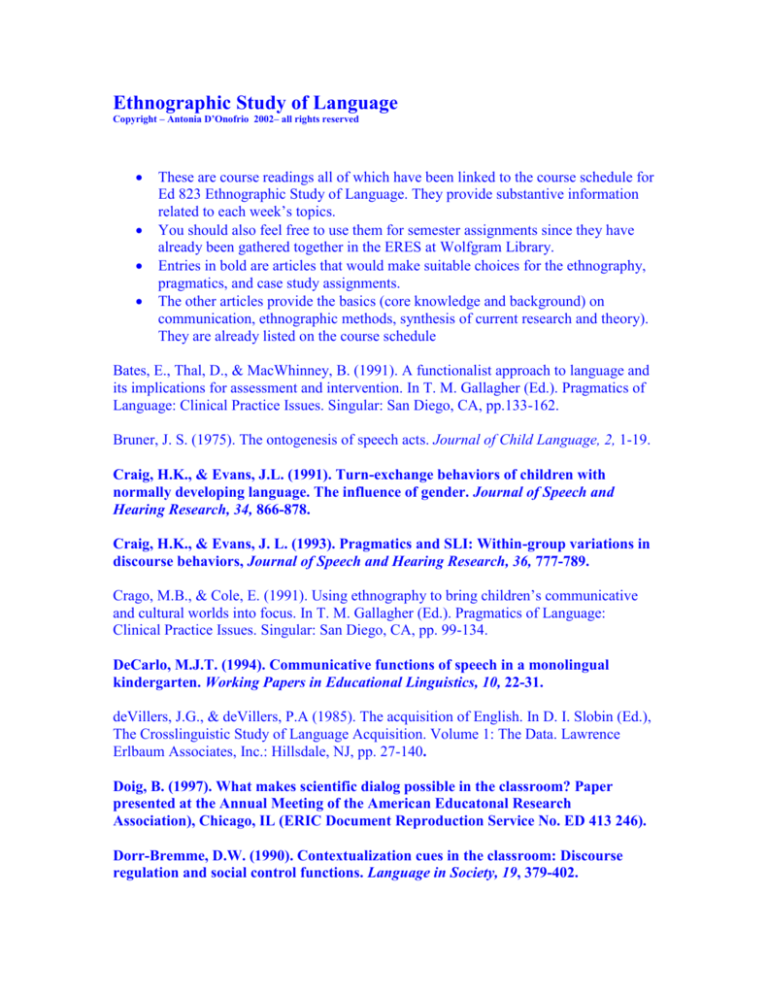
Ethnographic Study of Language
Copyright – Antonia D’Onofrio 2002– all rights reserved
These are course readings all of which have been linked to the course schedule for
Ed 823 Ethnographic Study of Language. They provide substantive information
related to each week’s topics.
You should also feel free to use them for semester assignments since they have
already been gathered together in the ERES at Wolfgram Library.
Entries in bold are articles that would make suitable choices for the ethnography,
pragmatics, and case study assignments.
The other articles provide the basics (core knowledge and background) on
communication, ethnographic methods, synthesis of current research and theory).
They are already listed on the course schedule
Bates, E., Thal, D., & MacWhinney, B. (1991). A functionalist approach to language and
its implications for assessment and intervention. In T. M. Gallagher (Ed.). Pragmatics of
Language: Clinical Practice Issues. Singular: San Diego, CA, pp.133-162.
Bruner, J. S. (1975). The ontogenesis of speech acts. Journal of Child Language, 2, 1-19.
Craig, H.K., & Evans, J.L. (1991). Turn-exchange behaviors of children with
normally developing language. The influence of gender. Journal of Speech and
Hearing Research, 34, 866-878.
Craig, H.K., & Evans, J. L. (1993). Pragmatics and SLI: Within-group variations in
discourse behaviors, Journal of Speech and Hearing Research, 36, 777-789.
Crago, M.B., & Cole, E. (1991). Using ethnography to bring children’s communicative
and cultural worlds into focus. In T. M. Gallagher (Ed.). Pragmatics of Language:
Clinical Practice Issues. Singular: San Diego, CA, pp. 99-134.
DeCarlo, M.J.T. (1994). Communicative functions of speech in a monolingual
kindergarten. Working Papers in Educational Linguistics, 10, 22-31.
deVillers, J.G., & deVillers, P.A (1985). The acquisition of English. In D. I. Slobin (Ed.),
The Crosslinguistic Study of Language Acquisition. Volume 1: The Data. Lawrence
Erlbaum Associates, Inc.: Hillsdale, NJ, pp. 27-140.
Doig, B. (1997). What makes scientific dialog possible in the classroom? Paper
presented at the Annual Meeting of the American Educatonal Research
Association), Chicago, IL (ERIC Document Reproduction Service No. ED 413 246).
Dorr-Bremme, D.W. (1990). Contextualization cues in the classroom: Discourse
regulation and social control functions. Language in Society, 19, 379-402.
Duchan, J.F. (1991). Everyday events: Their role in language assessment and
intervention. In T. M. Gallagher (Ed.). Pragmatics of Language: Clinical Practice Issues.
Singular: San Diego, CA, pp. 43-98.
Evans, J.L., & Craig, H.K. (1992). Language sample collection and analysis. Interview
compared to freeplay assessment contexts. Journal of Speech and Hearing Research, 35,
343-353.
Fisher, E. (1993). Distinctive features of pupil-pupil, classroom talk and their
relationship to learning how discursive exploration might be encouraged. Language
and Education, 7, 239-257.
Gallagher, T.M. (1991). Language and social skills: Implications for clinical assessment
and intervention with school-age children. In T. M. Gallagher (Ed.). Pragmatics of
Language: Clinical Practice Issues. Singular: San Diego, CA, pp 11-42.
Duchan, J.F. (1991). Everyday events: Their role in language assessment and
intervention. In T. M. Gallagher (Ed.). Pragmatics of Language: Clinical Practice
Issues. Singular: San Diego, CA, pp. 43-98.
Golinkoff, R. Michnick-. (1986). ‘I beg your pardon?”: The preverbal negotiation of
failed messages. Journal of Child Language, 13, 435-476.
Gutierrez, K. (1994). How talk, context, and script shape contexts for learning. A
cross-case comparison of journal sharing. Linguistics and Education, 5, 335-365.
Hornberger, N. J. (1995). Ethnography in a linguistics perspective: Understanding school
processes. Language and Education, 9, 233-258.
Hopper, P.J., & Thompson, J. (1993). Language universals, discourse pragmatics and
semantics. Language Sciences, 15, 357-376.
Jefferson, G. (1993). Caveat speaker: Preliminary notes on recipient topic-shift
implicature. Research on Language and Social Interaction, 26, 1-30.
Keifer, F. (1996). Bound utterances, Language Sciences, 18, 575-587.
Kelly, G.J., & Crawford, T. (1997). An ethnographic investigation of the discourse
processes of school science. Science Education, 81, 533-559.
Kirchner, D.M. (1991). Reciprocal book reading: A discourse-based intervention
strategy for the child with atypical language development. In T. M. Gallagher (Ed.).
Pragmatics of Language: Clinical Practice Issues. Singular: San Diego, CA, pp. 307332.
Larson, J. (1995). Talk matters: Theories of pivot in the distribution of literacy
knowledge among novice writers. Linguistics and Education, 7, 227-302.
Lee, O., & Fradd, S.H. (1996). Interactional patterns of linguistically diverse
students and teachers. Insights for promoting science learning. Linguistics and
Education, 8, 269-297.
Liles, B.Z. (1993). Narrative discourse in children with language disorders and children
with normal language: A critical review of the literature. Journal of Speech and Hearing
Research, 36, 868-882.
Merriam, S.B. (1988). The case study approach to research problems. In Case Study
Research in Education: A Qualitative Approach, Jossey-Bass: San Francisco, pp. 5-21.
Merriam, S.B. (1988). Writing the case study report. In Case Study Research in
Education: A Qualitative Approach, Jossey-Bass: San Francisco, pp. 185-206.
Morgan, J. (1993). Pragmatic language in early childhood education: Behavior and
thought in teaching. (Paper presented at the Annual Meting of the American
Educational Research Association), Atlanta, GA (ERIC Document Reproduction
Service No. ED 389 437).
Nelson, K. (1973). Learning to talk: A process model. In Structure and Strategy:
Learning to Talk. Monographs of the Society for Research in Child Development, 38,
(Serial no. 149), pp. 95-118.
Nippold, M.A. (1994). Persuasion talk in social contexts: Development, assessment and
intervention. Topics in Language Disorders, 14, 1-12.
Olstain, E. (1994). From interpersonal to classroom discourse: Developing research
methods. Working Papers in Educational Linguistics, 10, 1-17.
Purcell, S.L., & Liles, B.Z. (1992). Cohesion repairs in the narratives of normal
language and language disorders school age children. Journal of Speech and
Hearing Research, 35, 354-362.
Skrakis-Doyle, & Murphy, L. (1995). Discourse-based language intervention: An
efficacy study. Journal of Children’s Communication Development, 17, 11-22.
Stemmer, B. (1999). An on-line interview with Noam Chomsky: On the nature of
pragmatics and related issues. Brain and Language, 68, 393-401.
Sternberg, D.D. (1982/92). Sentence production and understanding. In Psycholinguistics:
Language, Mind and World. Longman: New York, pp.121-140.
Wolcott, H.F. (1995). The fieldwork part of fieldwork. In The Art of Fieldwork. Altimira
(Sage): Walnut Creek, CA, pp 63-85.
home

